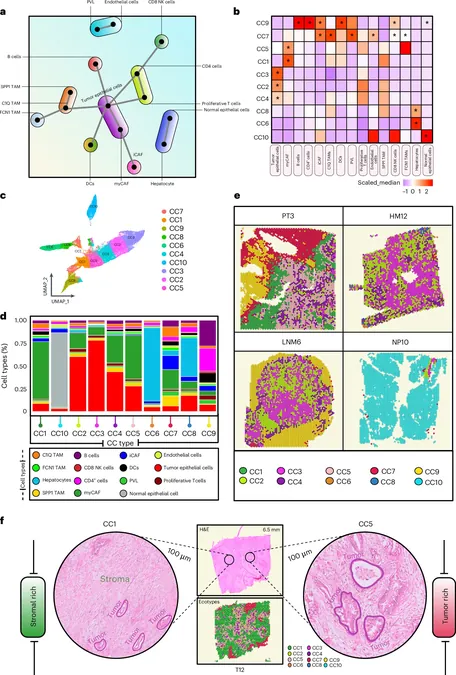
Groundbreaking Research Reveals Crucial Differences Between Primary and Metastatic Pancreatic Cancer
2024-10-04
Groundbreaking Research on Pancreatic Cancer
Researchers at the Indiana University Melvin and Bren Simon Comprehensive Cancer Center have made significant strides in understanding pancreatic cancer by mapping tumor ecosystems derived from both primary tumors and metastatic sites. This revolutionary study, recently published in Nature Genetics, highlights fundamental differences between these two types of disease manifestations, offering hope for new treatment strategies for this notoriously aggressive cancer.
Advanced Research Techniques
Senior author Ashiq Masood, MD, an associate professor of medicine at Indiana University School of Medicine, utilized advanced spatial transcriptomics—a cutting-edge technique that examines the interactions among cells in a specific tissue area—to investigate the complex ecosystems of pancreatic tumors. “In about 85% of pancreatic cancer cases, surgery isn't an option due to the disease's advanced stage or its spread to vital organs such as the liver,” Masood explained. This challenge has historically complicated efforts to obtain tumor tissue for comparative sequencing of primary and metastatic cancers.
Unique Position of IU Cancer Center
The IU Cancer Center is distinguished by its high-volume pancreatic cancer program, performing more surgeries for this cancer than any other center nationwide. This unique positioning has allowed researchers access to a diverse array of tumor samples stored in a comprehensive tissue bank, crucial for advancing cancer research.
The Impact of Pancreatic Cancer Statistics
Despite representing fewer than 4% of new cancer cases in the U.S., pancreatic cancer remains the third leading cause of cancer deaths, with the National Cancer Institute projecting over 51,000 fatalities from this disease in 2024 alone. The urgency of understanding pancreatic cancer’s behavior is underscored by these statistics.
Discoveries in Tumor Ecosystems
Leveraging tumor tissue from surgical resections involving cases of both primary tumors and disease that spread to the liver, pancreas, and lymph nodes, researchers identified seven distinct spatial 'neighborhoods' or spatial ecotypes within the tumors. Each of these regions exhibits unique cellular compositions and gene activity profiles vital for comprehending the disease's progression.
Towards a Tailored Treatment Approach
Traditionally, research has concentrated on the primary tumor; however, Masood emphasizes the importance of understanding metastatic behavior for developing effective therapeutic interventions. For instance, in the primary tumor's neighborhood, researchers identified a high concentration of fibroblasts, which play a crucial role in forming connective tissue. In contrast, metastatic tumors within the liver showed a proliferation of rapidly dividing cancer cells.
Implications for Future Research
The study’s findings suggest that treatments may need to be tailored to these distinct tumor ecosystems, even for patients presenting with the same type of cancer. Masood remarked, “The existence of varied tumor ecosystems within the same patient implies a need for different therapeutic strategies for each tumor type.”
Looking Ahead
Looking ahead, Masood plans to extend this research by examining pancreatic cancer ecosystems at a single-cell resolution while maintaining their spatial context. Future studies will also explore the roles of specific genes associated with different spatial ecotypes across various patients, with the ultimate goal of determining the influence of these ecotypes on patient prognosis and treatment responses.
Conclusion
This pioneering research stands to reshape our understanding of pancreatic cancer and could pave the way for more effective combination therapies tailored to individual patients and their unique tumor environments. With continued focus and innovation, researchers hope to make significant strides in the fight against one of the most lethal cancers known to modern medicine.




 Brasil (PT)
Brasil (PT)
 Canada (EN)
Canada (EN)
 Chile (ES)
Chile (ES)
 España (ES)
España (ES)
 France (FR)
France (FR)
 Hong Kong (EN)
Hong Kong (EN)
 Italia (IT)
Italia (IT)
 日本 (JA)
日本 (JA)
 Magyarország (HU)
Magyarország (HU)
 Norge (NO)
Norge (NO)
 Polska (PL)
Polska (PL)
 Schweiz (DE)
Schweiz (DE)
 Singapore (EN)
Singapore (EN)
 Sverige (SV)
Sverige (SV)
 Suomi (FI)
Suomi (FI)
 Türkiye (TR)
Türkiye (TR)